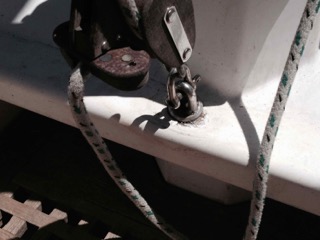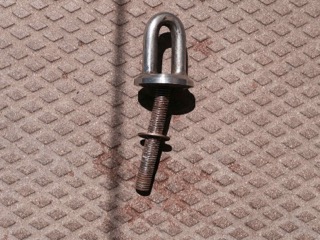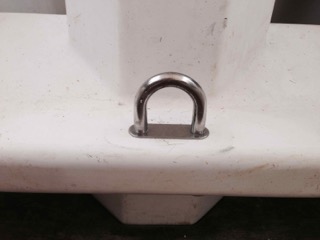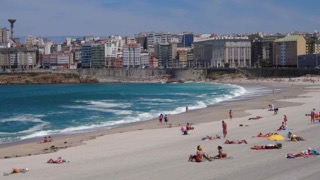41 22.297N 008 45.902W

|
Date: Sunday
26th July 2015 Position: Moored
in the marina at Povoa de Varzim I said in my previous to last blog that having crossed the Bay of Biscay
I felt that I had at last become a real sailor but this was just an illusion and
Sir Smug-a-lot was soon brought down to earth the next time I put to sea. I intended to leave La Coruna and make for
the Ria de Vigo on Wednesday 15th July but a rather basic mistake
set me back a day. I had re-provisioned,
topped up the water tank and the diesel I had topped up when I first arrived at
La Coruna Marina. The weather looked
good although it would be a little rough with winds predicted at 4 to 6
Beaufort, but from a northerly direction, which was perfect for me as I was
heading south. I left the marina a
little later than I had intended and got into the bay and made ready to set the
sails. I had noticed over the last
couple of days that the wind seemed to get up in the late afternoon and I had
already decided to put a reef in the main.
After all, it would be a lot easier to shake it out if necessary rather
than have to put one in especially as the state of the sea on the other side of
the breakwater was by now showing consistent “white horses”, white tops to the
waves indicating the wind was much stronger on the other side of the breakwater. I raised the mainsail put the first reef in
and slackened off the “topping lift”.
The “topping lift” is a line that goes from the top of the masthead to
the end of the boom and holds the boom horizontally in place when the sail is
not being used. If you didn’t have a
topping lift the boom would crash down into the cockpit. However, when you have the sail up, the sail
holds the boom in place and the topping lift has to be slackened off so the
sail can create the proper shape.
Anyway, I un-cleated the topping lift and made a basic error of letting go
the end while I adjusting the reefing line on the other side of the mast. When I returned to make fast the topping lift
I could not find the end of the line anywhere.
Of course I couldn’t because the wind had got hold of the unsecured line
and it was now flying all over the place up in the rigging and within moments
it was tangled around the wind generator, the VHF aerial and a bunch of other
lines. I had made the decision to leave
so I was reluctant to go back to the marina when a brilliant idea hit me, all I
had to do was pull the line through the top of the masthead then I could either
sort the problem out immediately or at least secure the line so it wouldn’t cause
any damage until I could fix it later.
Great, so I got hold of the line and started to pull forgetting that I
had put a stopper knot in the end of it so when it hit the block at the top of
the mast it got stuck. Now I couldn’t get
the end of the line without going up the mast and I had even more line flying
about crashing into everything aloft. I
kept trying to think of ways of resolving the issue at sea because I really wanted
to be on my way, but all the time I knew there was only one sensible
solution. Eventually I gave in and
returned to the marina. It was late so I
decided to stay one more night and leave the next day. It was a good decision to return to the
marina because in the end what seemed a simple job to took two hours to
complete. First I had to get all the
equipment needed for the job, which as I have said before meant pulling the
lockers to pieces to find everything. Then
I had to climb up the mizzen mast to untangle the line at that end and then climb
up the main mast to untangle the line at that end and finally pull it back
through the block. When I say climb up
the mast it sounds so simple. Usual,
when you have crew on board it is quite simple you use a bosuns chair to sit in
while one of the crew members winches you up on a halyard. I mostly sail solo but even if Ann where with
me she could hardly winch a lump like me up to the top of the mast. So knowing that there would be times when I had
to go up the mast I brought a system that you can use independently. Pre planning is so important! You still use a bosuns chair but there is a block
mechanism attached to it with a spring loaded leaver that clamps the halyard in
place if any load is put on it. There is
also a strap for your feet with a similar device attached. You feed the halyard through
the gap between the block and lever on both
parts and the principle is that as you put a load on one part it releases the
load on the other part so that now you can push the lever forward and move the
block up or down the halyard. So basically you sit in the bosuns chair pull
your legs up as high as you can while moving the block attached to the leg
straps up the halyard then stand up on the leg straps to pull yourself up. The load is released from the bosuns chair
which can now be moved up the halyard before sitting down and moving the leg
straps again. You continue this process
until you reach whichever part of the mast you need to reach and then do it in
reverse to come down again. It is not
easy and takes some getting used to but it is very effective, albeit slow, and
the bosuns chair is quite comfortable if you are up the mast for any length of
time. Being the fat old lump I am I have
to have a rest halfway up the main mast so having a comfortable seat is a
bonus. Anyway, job done I finally set sail the next day at twelve noon but had
missed my window of opportunity weather wise.
For the last two days it had been almost perfect but the wind was now
forecast from the south at 4 – 6 Beaufort, which was exactly where I was
heading. So it was motor sailing all the
way into between 12 to 18 knots of wind and waves of around 2 – 3 metres, which
knocks the boat speed down considerable. At 2000 rpm I can usually cruise at
5.3 knots but in these conditions I was down to 3.5 knots so it was going to be
long slog of a passage. By morning the
wind had died down to about 5 knots so the sea became much calmer and the boat
speed increased. I had noticed that
around these northern Rias of Spain you tend to get fog early in the morning
and quite often in the late afternoon as well.
It was 8 am and the fog had descended so I had the radar on picking up
the small fishing boats all around me. I
was not that far from the Ria de Vigo so there where plenty of then to
avoid. As the fog lifted I could see the
Islas Cíes, three large islands at the mouth of the Ria de Vigo, which protect
the Ria from most of the Atlantic swells.
The Islas Cíes are mountainous, wooded and very attractive. They are made up of three islands, although
two of them are actually connected to each other. All three islands, Isla del Norte, Isla del
Faro and Isla de San Martín are National parks and bird sanctuaries but there are
several anchorages there and as I later found out the islands are a very
popular destination for day-trippers with regular ferries from Cangas, Vigo and
Baiona. Once passed the Islas Cíes I decided that rather than going to Vigo directly,
I would go to Congas instead and spend one or two nights at anchor. I arrived at Congas at 2 pm and put the
anchor down. The passage had taken 26
hours but had the weather been in my favour I reckon I could have done it in 20
hours or less. Once I had sorted the
boat and myself out, I decided to go into town but rather than getting the
tender out I used the canoe instead. I
paddled to the beach, getting a little wet in the process and walked into town,
which wasn’t far away. Congas is a small
fishing town and holiday destination.
There is a lovely long beach for the tourists, which was crowded most of
the day. The small harbour is divided
into three parts, one area for fishing boats, another for the regular ferries
to Vigo (every half hour during the week) and the Islas Cíes and finally a
small marina which was full, but then I was happy to stay at anchor. I spent three days in total anchored at Congas and on the last day,
Sunday 19th July, I decided to take a ferry to Vigo to have a look
around the city. I had done my research
the day before and found out that on a Sunday the ferries left every hour on
the hour for Vigo and returned to Cangas every half hour. The cost of a return ticket was 16€ or so I
thought. The reason I had this
impression was because when I asked the lady behind the ticket desk about the
cost she pointed at a sign saying 1600 which I took to mean 16€. What I didn’t realise was that you couldn’t
buy a return ticket you had to buy a ticket from Cangas to Vigo and then buy
another ticket at Vigo to return to Cangas.
Also, you could only buy a ticket for a specific time so what she
actually pointed at was the time of the next sailing to Vigo and not the cost I
which is what I had assumed. You know
what they say, “assumption is the mother of all ****ups” but in this case it
turned out to be a bit of a bonus. I thought
that 16€ (£12 approx.) seemed a very reasonable price for a return ticket
considering the distance and knowing the cost of a ferries to the Isle of Wight. So, Sunday morning I turned up for the 11 am
crossing and presented 16€ to the lady behind the counter and tried to asked
for a return ticket to Vigo. She looked
at me a little strange as she gave back the 10€ note and the 1€ coin I had just
given her and only took 5€ note. I was
even more astounded when she gave me a ticket, one way of course, and change
from the 5€. The cost turned out to be
2.20€ which is approximately £1.58 each way.
You try going to Lymington and getting a ferry to the Isle of Wight for
£1.58, they would laugh at you all the way to the funny farm. A day return to the Isle of Wight for a foot
passenger is £14.20 for a journey that is not that much further than Congas to
Vigo I would say. I arrived in Vigo at 11.15 am and decide that my decision to anchor at
Congas rather than make for Vigo direct had been a good one as Vigo did not
exactly blow my socks off. There was no
seafront to speak of, most of it being a fishing and commercial port, but there
were a few bars and restaurants along the front. As the ferry was arriving I did notice that
there was a marathon or fun run going on in the city. I came upon the finishing point for the event
quite by chance. There was loud music
playing and loads of people hanging around in party mood, which kind of
surprised me a bit because I would have thought you would been quite tired out
after a long run. But all became clear when
I looked at the posters for the event, which proudly displayed in large words
across the top “Beer Runners”. I looked
around and saw lots of stalls handing out beer and burgers to every one. Not
your usual bottle of water and silver blanket you get in the UK! Now that’s what I call a “Fun Run”! I moved on and decided to look for somewhere to have lunch. I had already passed through an area, a
covered walkway, with about a dozen restaurants in it that looked interesting
so I made my way back there. When I had
passed through earlier it was pretty deserted but the place had a bit more of a
buzz about it now. I knew from the start
that it was not going to be a cheap meal because it was obviously a tourist
attraction, which adds at least 10% to the bill straight away. But this was only the second time I had eaten
out since I left the UK so I wasn’t to concerned about the price. The place reminded me a bit of Brick Lane on
Saturday night with all the waiters outside each restaurant touting for
business and it became obvious that fish was the mainstay of all of them. The second reason I knew it wasn’t going to
be cheap! There where a few stalls
opening oysters and you could buy a plate of them and then take a table at any
of the restaurants to eat them. I am not
an oyster lover so I took a seat at the nearest table and ordered a beer. It is the same in any tourist area in any
city you go to, eventually the beggars and street venders start to appear. It started with a chap playing an accordion, which for a little while livened the place up, but
you knew what was coming. Isn’t it
strange that no matter how hard you try not to make eye contact with someone
who is desperately trying to make eye contact with you, its is just to strong
an impulse to resist! I could feel his eye boring into my back and just for a
nano second, a gnats breath I turned my head slightly and he was on me like a
shot with his hand out. It reminded me
of a sketch Don Joly did on is TV show Trigger Happy TV. He would walk up to unsuspecting tourist in
London, sing in an appalling voice then suddenly stop and put his hand out for
some cash. Similarly, I soon realised
the man with the accordion had a very limited repertoire. After he had relived me of 1€ he moved on to
his next victim and stared at them until eventually they also caved in. Next came the African street traders touting
their hats, belts and other such unwanted tat.
I was surprised that none of the staff at the restaurants made any
attempt to move them on but I suppose they had a captive audience so they
didn’t care. I ordered some Calamari to
start with and then had a plate of mixed grilled shellfish all of I which I
enjoyed. Don’t you find there is
something satisfying about eating food with your hands and having to work for
it! I suppose there is something
primeval about the experience. I have
had the privilege of seeing and tasting some of the best food you could
imagine, pictures on a plate. But even
so, pulling a crab to bits with your hands and taking time to eek out every
last bit of meat from it is just fantastic, especially with a nice chilled
glass of Vino Blanco. As I expected to
bill came to 60€ but it had been a good meal so I didn’t care. I paid and I returned to the boat. The next day, Monday 20th July, I moved on to Baiona, another
holiday resort about 10 miles from Cangas.
There was plenty of room in the bay so I anchored instead of going onto
the marina. There where at least eight
other yachts that had had the same idea who where also anchored in the
bay. As I said this was more of a
holiday resort than anything else so facilities were limited. The supermarket was a good twenty minutes
walk way but I had most of what I needed on board so only had to visit it once
on my last day. According to the pilot
book the marina had a chandlers but his stock was very limited. I did have to make one running repair while I
was laid up there. Remember I mentioned
about Ann nearly loosing her head that time we had an accidental gibe. Well in addition to smashing the gooseneck
the padyeye, a bolt with a “U” shaped end that the bottom of the mainsheet is
attached to, had been bent and compressed the GRP at its base. At the time the damage was not enough to
cause a problem but I had noticed on my sail to Baiona that the padyeye had
worked looser and was causing more damage to the GRP so it had to be repaired. I was intending to replace the padyeye with a
traveller system which would have been much more expensive but could not decide
on which system would be best. So I
called Rob at Kemp Sails in Wareham for some advice and I am glad I did. Without going into technical detail he
explained that because of the type of boat I had and because of the type of
sailing I was doing, installing a traveller system would be of limited value
but would cost a great deal of money. He
advised me to replace the padyeye with a “U” bolt which should be much
stronger. So I did at a cost of 7€
rather than spending hundreds or even thousands on a traveller system. Thanks Rob!
I made rather a good job of the repair although I say so myself. First I removed the padyeye and you can see
how bent it was by the photo. It might
have lasted a bit longer but it was bound to go at some stage and probably at
the most inopportune moment had I left it.
Next I ground out all the damaged GRP and filled the hole with epoxy
filler and finally finished with a coating of white gelcoat filler, good as
new. I can’t really say much more about
Baiona as there really was not much more to see. I did visit the yacht club, which was very
posh. It is in the grounds of a very grand
hotel which is surrounded by a historic fort.
The hotel has its own beach and you are supposed to have a pass to gain
access but I, along with a few others, just walked in unchallenged. That was about it for Baiona so I left
Thursday 23rd July and made my way to Pavoa de Varzim, my first port
of call in Portugal, which is where I am now.
Anyway, I will leave you for now and tell you about Pavoa de Varzim in
my next blog. Bye for now. Signing off Ted
Beer runners unite One of the beaches at La Coruna   I guess some people just cannot like without satellite TV The offending Padyeye   Good job I decided to replace it The finished repair
|

